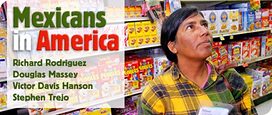Doug Massey is right. The debate about Mexican immigration easily turns emotional, and it often aggravates Americans’ feelings of insecurity that are not directly related to immigration. September 11 and subsequent events have intensified these emotions, but sizeable immigration flows to the United States have always provoked similar responses, both in modern times with respect to Mexican immigration (e.g., the debate leading up to the 1986 Immigration Reform and Control Act, or California’s Proposition 183), and throughout our history with respect to previous immigration waves.
Nonetheless, I agree with Victor Davis Hanson that the illegal nature of most Mexican immigration is a big problem, even for those who believe that on the whole the United States benefits from such immigration. In addition to the issues that Hanson raises, there is the fundamental point that before we can hope to reform U.S. immigration policy, we must first gain better control over who enters the country. As amply demonstrated by the research of Massey and others, Mexicans still seem to find it relatively easy to enter the United States outside of our official admissions system. Until that changes, discussions about the best U.S. policy toward Mexican immigration remain largely academic.
Therefore, to my mind, the critical question is: how do we begin to control illegal immigration from Mexico? I don’t know the answer. I have no particular expertise on this topic, so I’m hoping for guidance from those of you with more knowledge about the issue. But let me indulge in a few observations.
Border enforcement cannot be the primary answer. In recent years, we have dramatically increased expenditures on manpower and technology aimed at stopping illegal border crossing, with minimal results (and, as Massey points out, often counterproductive ones). If we continue trying to control illegal immigration in this fashion, we will spend huge sums of money to little effect.
Given that most illegal immigrants come to the United States to work, why don’t we get serious about workplace enforcement? Retail stores are able to verify in a matter of seconds consumer credit cards used to make purchases. Why couldn’t a similar system be put in place to verify the Social Security numbers of employees before they are hired? Many European countries have systems like this in place. Why don’t we try out something like that? Are Americans really that opposed to national identification cards? I realize that, in many ways, the immigration situation in Europe is different from that in the United States. I also realize that an electronic verification system would miss immigrants employed in the underground economy. But I suspect that we could do much more to control illegal immigration by directing technology and other enforcement resources toward the workplace rather than toward our porous southern border.

